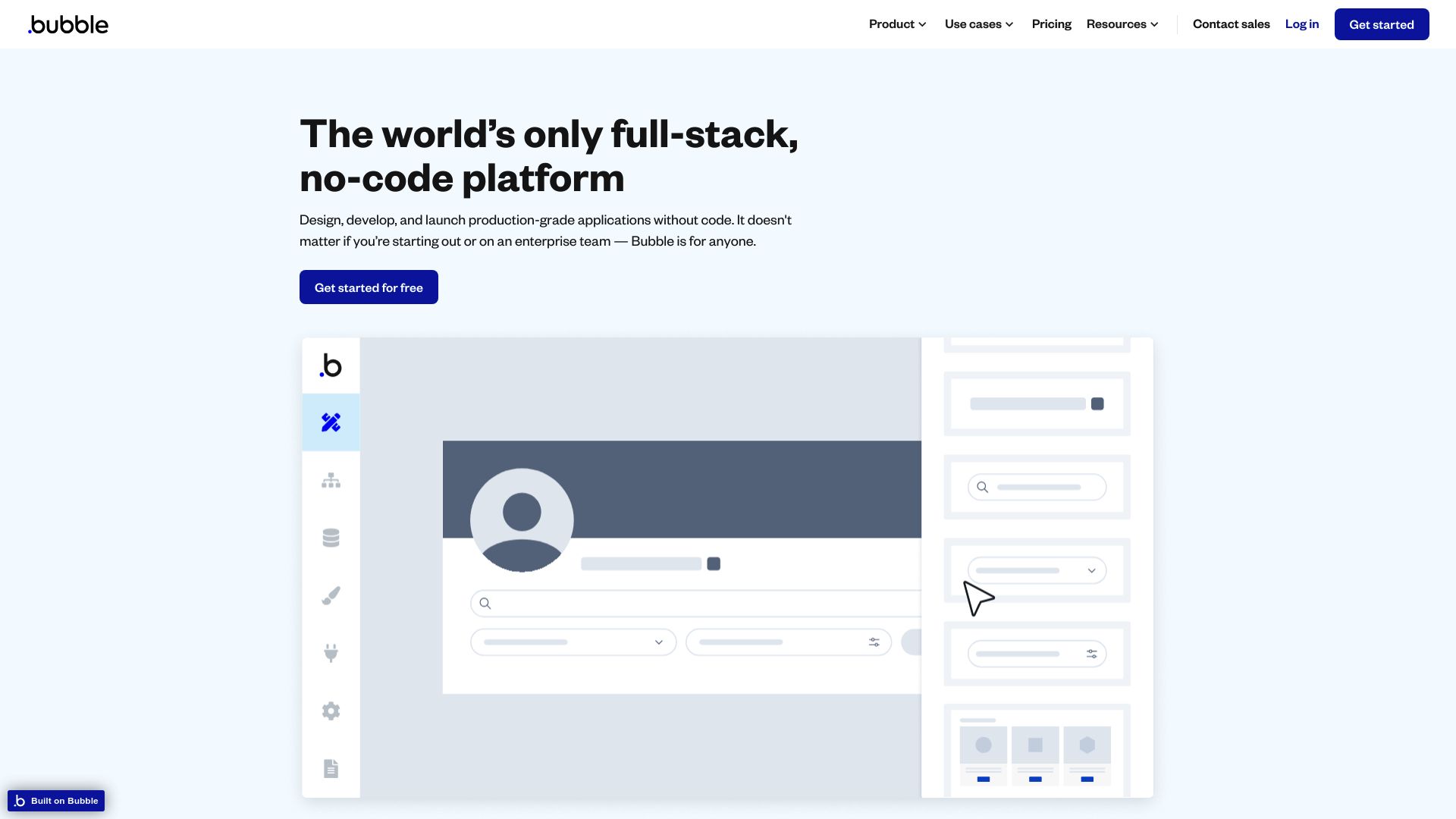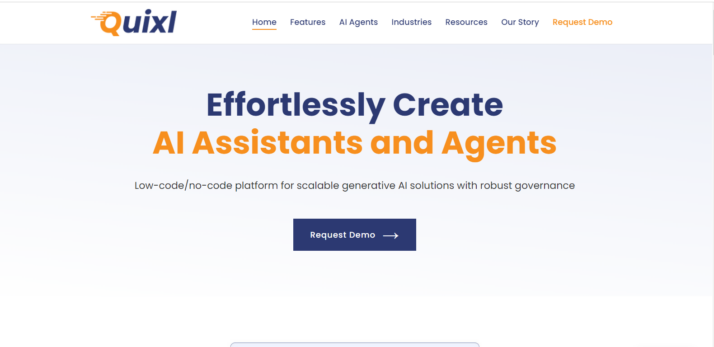Bubble vs. Quixl AI: Comparing No-Code and AI Agent Platforms
The AI landscape evolves rapidly, presenting diverse solutions for software development and AI integration. This comparison explores Bubble vs. Quixl AI, and SmythOS, three platforms reshaping how businesses leverage AI technology. Bubble’s no-code approach democratizes web application development, while Quixl AI specializes in AI agent creation and deployment. SmythOS emerges as a comprehensive solution, combining powerful AI capabilities with user-friendly interfaces. We’ll examine each platform’s strengths, limitations, and unique features to help you decide which best suits your project needs. Whether you’re a developer seeking advanced AI integrations, a business leader focused on scalability, or an entrepreneur looking for accessible AI tools, this analysis provides insights to guide your choice in the competitive AI software market.
Bubble Overview
Bubble empowers users to create web applications without coding. Its visual interface allows drag-and-drop assembly of complex web apps, opening app development to non-technical users. Bubble’s platform caters to entrepreneurs, small businesses, and enterprises seeking to rapidly prototype and launch web-based products.
The core of Bubble’s offering is its no-code development environment. Users can design interfaces, define workflows, and manage databases through an intuitive visual editor. This approach significantly reduces the time and technical expertise required to build functional web applications. Bubble also facilitates AI integration, allowing users to incorporate advanced features like natural language processing and image recognition into their apps through APIs and plugins.
Bubble empowers users to create web applications without coding. Its visual interface allows drag-and-drop assembly of complex web apps, opening app development to non-technical users.


Bubble’s platform shines in its extensibility. A marketplace of plugins and templates allows users to add pre-built functionality or start with industry-specific designs. This ecosystem accelerates development and enables the creation of sophisticated applications without reinventing the wheel. For those requiring custom features, Bubble supports JavaScript and API integrations, bridging the gap between no-code and traditional development.
A marketplace of plugins and templates allows users to add pre-built functionality or start with industry-specific designs. This ecosystem accelerates development…
While Bubble excels in web application development, it has limitations. The platform primarily focuses on web apps, with limited options for native mobile app development. Additionally, while Bubble applications can scale, very high-traffic or data-intensive applications may face performance challenges compared to traditionally coded solutions. Users should also consider the long-term implications of building on a proprietary platform, as migrating a Bubble app to another technology stack can be complex.
Quixl AI Overview
Quixl AI, developed by Integra, offers a comprehensive platform for AI integration and deployment across various industries. The platform’s standout feature is its no-code AI agent builder, which leverages generative AI and large language models (LLMs) to streamline automation and boost productivity.


At the heart of Quixl AI lies the AI Agents Hub, a repository of pre-built agents ready for quick deployment. This feature accelerates the adoption of AI technologies, allowing businesses to implement intelligent solutions without extensive development time. The platform also includes a Prompt Studio for advanced prompt-engineering, enabling users to fine-tune AI responses for specific use cases.
Quixl AI excels in supporting seamless AI integration, rapid deployment, and scalable growth. Its applications span diverse fields, from alt-text generation and manuscript assessment to enterprise knowledge search and content editing.
Quixl AI excels in supporting seamless AI integration, rapid deployment, and scalable growth. Its applications span diverse fields, from alt-text generation and manuscript assessment to enterprise knowledge search and content editing. The platform caters to specific industries like Media and Entertainment, Publishing and EdTech, and Healthcare, enhancing user engagement, personalizing learning experiences, and automating administrative tasks.
Quixl AI’s approach to AI monetization, coupled with its robust API Gateway, positions it as a versatile tool for businesses of all sizes. The platform prioritizes data security, offering advanced transfer mechanisms to protect sensitive information. Its cost-effective and adaptable design supports both on-premises and cloud deployments, making advanced AI accessible to a wide range of organizations.
While Quixl AI offers impressive capabilities, it’s worth noting that the platform may have limitations in areas such as autonomous agent deployment or specialized features like sitemap crawling. Users should carefully evaluate their specific needs against Quixl AI’s offerings to ensure a good fit for their projects.
Feature Comparison
Bubble and Quixl AI offer distinct approaches to software development and AI integration. Bubble excels as a no-code platform for web application development, while Quixl AI focuses on AI agent creation and deployment.
Bubble’s visual builder and no-code editor empower users to create web applications without coding expertise. It supports integrating AI functionalities through APIs and plugins, allowing developers to enhance applications with AI capabilities like chatbots and recommendation engines. Bubble provides both development and production environments, enabling thorough testing before deployment. However, Bubble lacks specific features for AI agent hosting, autonomous agents, or multi-agent collaboration.
In contrast, Quixl AI specializes in AI agent development with its no-code AI agent builder. It offers pre-built agents through its AI Agents Hub for quick deployment across various industries. Quixl AI’s Prompt Studio allows for advanced prompt engineering, giving users greater control over AI responses. Unlike Bubble, Quixl AI focuses on seamless AI integration and rapid deployment of intelligent solutions. However, Quixl AI may have limitations in general web application development compared to Bubble’s comprehensive toolkit.
Both platforms prioritize security, with Bubble using TLS and AES-256 encryption for data protection. Quixl AI emphasizes data security with advanced transfer mechanisms. While both support API integrations, Quixl AI’s API Gateway may offer more robust options for AI-specific implementations. Bubble’s strength lies in its extensive plugin ecosystem and integration capabilities with various third-party services, whereas Quixl AI’s power comes from its specialized AI agent creation and industry-specific solutions.
Feature Comparison Table
| Bubble | Quixl AI | SmythOS | |
|---|---|---|---|
| CORE FEATURES | |||
| Memory & Context | ❌ | ✅ | ✅ |
| Autonomous Agents | ❌ | ✅ | ✅ |
| Explainability & Transparency | ❌ | ✅ | ✅ |
| Multimodal | ❌ | ✅ | ✅ |
| Multi-Agent Collaboration | ❌ | ✅ | ✅ |
| Bulk Work | ❌ | ✅ | ✅ |
| Agent Work Scheduler | ❌ | ✅ | ✅ |
| SECURITY | |||
| Constrained Alignment | ❌ | ✅ | ✅ |
| IP Control | ❌ | ✅ | ✅ |
| COMPONENTS | |||
| Huggingface AIs | ❌ | ✅ | ✅ |
| Classifiers | ❌ | ✅ | ✅ |
| DEPLOYMENT OPTIONS (EMBODIMENTS) | |||
| Deploy as API | ❌ | ✅ | ✅ |
| Deploy as Scheduled Agent | ❌ | ✅ | ✅ |
| DATA LAKE SUPPORT | |||
| Hosted Vector Database | ❌ | ✅ | ✅ |
| Sitemap Crawler | ❌ | ❌ | ✅ |
| YouTube Transcript Crawler | ❌ | ❌ | ✅ |
| URL Crawler | ❌ | ❌ | ✅ |
Best Alternative to Bubble and Quixl AI
SmythOS stands out as the premier alternative to Bubble and Quixl AI, offering a comprehensive platform for AI agent development and deployment. We combine the best of both worlds: the intuitive design of Bubble’s no-code approach and Quixl AI’s focus on AI integration, while surpassing both in functionality and versatility.
Our drag-and-drop interface simplifies the creation of complex AI workflows, making advanced AI development accessible to users of all skill levels. Unlike Bubble’s limited AI capabilities, SmythOS provides a robust ecosystem for building and deploying autonomous AI agents. We offer seamless integration with a wide array of AI models, APIs, and data sources, surpassing Quixl AI’s offerings in breadth and depth.
SmythOS excels in multi-agent collaboration, a feature absent in Bubble and more limited in Quixl AI. Our platform enables the orchestration of multiple AI agents working together on complex tasks…
SmythOS excels in multi-agent collaboration, a feature absent in Bubble and more limited in Quixl AI. Our platform enables the orchestration of multiple AI agents working together on complex tasks, dramatically increasing the potential for sophisticated AI solutions. We also provide superior memory and context management, ensuring AI agents maintain coherent, context-aware interactions over extended periods.
Unlike our competitors, SmythOS offers unparalleled flexibility in deployment options. We support deployment as APIs, webhooks, scheduled agents, and even as ChatGPT plugins, catering to a wide range of use cases and integration scenarios. Our platform also includes advanced features like a hosted vector database, sitemap crawler, and YouTube transcript crawler, expanding the possibilities for data ingestion and processing.
With SmythOS, we’ve eliminated the constraints that limit other platforms. Our solution offers unlimited use cases, from simple chatbots to complex, industry-specific AI applications. We provide the tools and capabilities to tackle any AI challenge, making SmythOS the ideal choice for businesses and developers looking to harness the full potential of AI technology.
Conclusion
Bubble, Quixl AI, and SmythOS each offer unique approaches to software development and AI integration. Bubble excels in no-code web application development, making it accessible for non-technical users to create complex web apps. Quixl AI focuses on AI agent creation and deployment, offering pre-built agents and industry-specific solutions. However, SmythOS emerges as the superior choice, combining the strengths of both platforms while offering additional advanced features.
SmythOS stands out with its comprehensive approach to AI agent development and deployment. Our platform’s drag-and-drop interface rivals Bubble’s ease of use, while our extensive integration ecosystem surpasses both competitors. With support for over 300,000 integrations, SmythOS offers unparalleled flexibility in connecting various data sources, APIs, and AI models.
Unlike Bubble and Quixl AI, SmythOS provides robust multi-agent orchestration, allowing for collaborative AI systems that can tackle complex tasks. Our “Create Once, Deploy Anywhere” philosophy ensures that agents can be seamlessly integrated across multiple platforms, from ChatGPT plugins to Alexa skills. This versatility, combined with our advanced features like autonomous agents, multimodal capabilities, and sophisticated debugging tools, positions SmythOS as the ideal choice for businesses looking to harness the full potential of AI.
To experience the power of SmythOS firsthand, explore our diverse range of AI-powered agent templates. These templates cover multiple business categories and offer a quick start to streamline your processes. Ready to revolutionize your workflow with intelligent agents? Create a free SmythOS account and start building AI agents with no time limit. Join us in shaping the future of AI-driven innovation and efficiency.
Last updated:
Disclaimer: The information presented in this article is for general informational purposes only and is provided as is. While we strive to keep the content up-to-date and accurate, we make no representations or warranties of any kind, express or implied, about the completeness, accuracy, reliability, suitability, or availability of the information contained in this article.
Any reliance you place on such information is strictly at your own risk. We reserve the right to make additions, deletions, or modifications to the contents of this article at any time without prior notice.
In no event will we be liable for any loss or damage including without limitation, indirect or consequential loss or damage, or any loss or damage whatsoever arising from loss of data, profits, or any other loss not specified herein arising out of, or in connection with, the use of this article.
Despite our best efforts, this article may contain oversights, errors, or omissions. If you notice any inaccuracies or have concerns about the content, please report them through our content feedback form. Your input helps us maintain the quality and reliability of our information.
